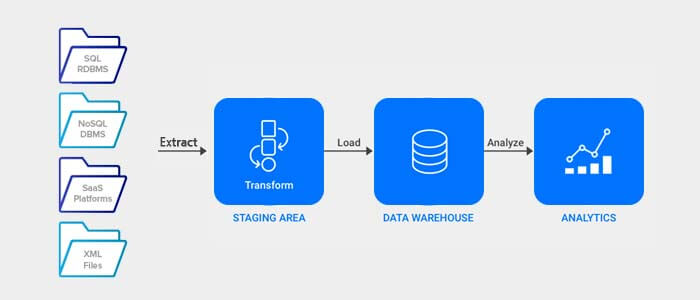
The primary goal of ETL tools is to extract, convert, and load information from one database source to another, as well as to speed up the data integration process within the organization as quickly as possible. The three primary components of ETL Tools are as follows:
Central Repository
This is where all of the standard operating procedures and mappings entities are stored in one location.
Business Rules Editor
This allows you to create business requirements as they relate to validations, mappings, and other features using a wizard-driven graphical interface.
The Run-time Execution Engine (RTE)
Is where the mapping rules and flow transactions are performed on incoming files and messages during the execution phase.
As a solution for automating any structure, ETL is a solution for any structure. Packages are made up of tasks that may transfer data from one location to another while also altering it in the process. In addition to assisting in the development of these packages, Graphic Strategists, who are housed within the Business Analytics Development Studio (BIDS) software package, also assist in researching the application programming interface to manipulate objects from other programs.
There are many advantages to using ETL tools, and they are a highly efficient solution for dealing with data fragment problems. The technologies may provide improved connection, allowing IT teams to make changes to applications and data sources without having to restructure the interface layer entirely. Companies may create an integrated ecosystem in which information solutions can simplify regulatory reporting, improve client experiences, engage target audiences, and generate top-line growth by integrating data from many sources. Some of the advantages include the following:
The advantages of utilizing an ETL tool versus an open-source data programming language are discussed below:
Since data extraction, transformation, and loading (ETL) tools are intended to do so, they have transforms integrated into them that make typical data operations such as data computations, joins, and other conversions extremely fast and simple. You won't have to create any code to connect data from two different sources since ETL Tools will take care of it for you. ETL Tools also have built-in data connections that allow users to retrieve and transfer the information in batches, eliminating the need to learn numerous new APIs and possibly saving time throughout the development process.
ETL tools are intended to be used in conjunction with one another to create data pipelines and execute transformations. Thus, rows of data are being converted and put into my destination table before all of my data has been retrieved from the source, and data may flow through branches of pipelines at the same time. As a result, you don't have to wait for the data to fully load into your computer's memory before you can perform transformations on it and insert it into the target table inside the data warehouse, which may speed up the extraction, transformation and loading process. Beyond that, ETL Tools are developed and supported by teams of experts who are always striving to enhance speed and reliability. It may involve sophisticated engineering around how the ETL Tool works, which may include data stored in the server's storage and CPU caching.
Due to their data pipelining capabilities, ETL tools make it easy to identify and eliminate potential failure points (what to do if only changes for column subsets). A string in a numeric field will cause an ETL Tool to bomb only for that specific column if the device is running on a Windows PC. For this situation, any remaining columns will be stacked into the objective table, and we might give an alternate course to the one that neglected to stack. ETL Data Integration Tools automatically provide data flow visualizations, which would otherwise be required to be manually generated if open-source data scripting languages were used. It makes it easier to keep track of complex data flows. Organizations operating in complex settings may benefit greatly from the inclusion of these kinds of capabilities. In complex settings, the amount of maintenance required to move data using scripting languages can quickly become cumbersome.
In addition to these features, ETL tools provide for simple monitoring of alerts (for failures, for instance) as well as built-in monitoring of assigned activities. In open-source scripting, many of the advantages of ETL tools are also possible; however developers would have to reimagine the wheel by writing custom code to achieve all of the above advantages; however, writing custom code requires constant upkeep and can be a very time-consuming process.
Recent Blogs
Categories



